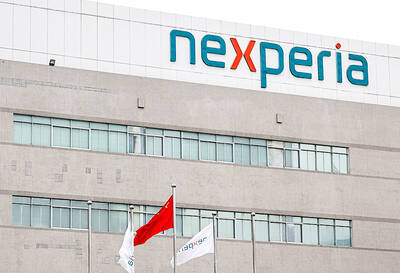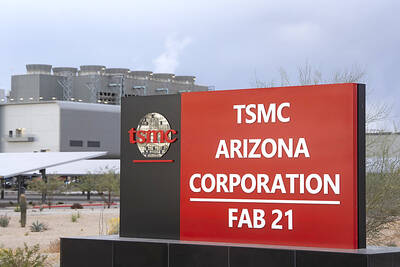Smartphone maker HTC Corp (宏達電) has reported another quarterly net loss in the third quarter of the year, although its gross margin continued to improve.
In a statement on Tuesday, HTC said that it reported a net loss of NT$770 million (US$27.63 million) in the July-to-September period, higher than the NT$550 million net loss a quarter earlier.
Hurt by its struggling smartphone business, HTC has run a net loss every quarter since the second quarter of 2015, except for the first quarter of 2018, when an asset sale helped it post a quarterly net profit.

Photo courtesy of HTC Corp via CNA
Its losses per share in the third quarter rose for the first time in five quarters to NT$0.94, from NT$0.68 in the second quarter, as it continued to encounter stiff competition in the global smartphone market.
However, HTC’s gross margin — the difference between revenue and cost of goods sold — continued to climb in the third quarter to 31.6 percent from 29.9 percent in the second quarter.
In addition, HTC’s operating loss fell to NT$880 million in the third quarter from NT$1.05 billion in the second quarter, helped by a slightly improved operating margin — the difference between sales, the cost of goods sold and operating expenses — of minus-65.8 percent, compared with minus-77.8 percent in the second quarter.
Analysts said that the improving gross margin largely reflected HTC’s efforts to diversify its product mix and develop its virtual reality business to take pressure off its lackluster smartphone sales.
In September alone, HTC posted consolidated sales of NT$601 million, up 64 percent from a year earlier.
It was the company’s second-highest monthly sales figure for the year, behind its NT$664 million in June.
The increase in September sales came after the company unveiled the HTC Vive Pro 2 virtual reality (VR) headset.
Still, HTC’s consolidated sales for the third quarter fell by 0.7 percent from a quarter earlier to NT$1.34 billion.
HTC, which launched its first VR headset — the HTC Vive — in 2015, has seen rising demand for its VR gadgets amid a booming stay-at-home economy.
The latest VR gadget from HTC — the Vive Flow — went on sale in Taiwan on Monday.
The lightweight, compact immersive glasses, weighing no more than 189g, have an expansive 100° field of view, 3.2K resolution, a 75 Hertz refresh rate and full 3D spatial audio that can also connect to external Bluetooth earphones, the company said.
Analysts have said that the portable Vive Flow is HTC’s attempt to embrace the so-called “metaverse” concept talked up by Facebook Inc chief executive officer Mark Zuckerberg since July.
The metaverse — a term coined by Neal Stephenson in his 1992 book Snow Crash — refers to a digital world where people can move between devices and communicate in a virtual environment.
Charles Huang (黃昭穎), general manager for the HTC Vive in the Asia-Pacific region, said that the Vive Flow is expected to go on sale in other countries later in the fourth quarter or in the first quarter of next year.

JITTERS: Nexperia has a 20 percent market share for chips powering simpler features such as window controls, and changing supply chains could take years European carmakers are looking into ways to scratch components made with parts from China, spooked by deepening geopolitical spats playing out through chipmaker Nexperia BV and Beijing’s export controls on rare earths. To protect operations from trade ructions, several automakers are pushing major suppliers to find permanent alternatives to Chinese semiconductors, people familiar with the matter said. The industry is considering broader changes to its supply chain to adapt to shifting geopolitics, Europe’s main suppliers lobby CLEPA head Matthias Zink said. “We had some indications already — questions like: ‘How can you supply me without this dependency on China?’” Zink, who also

The number of Taiwanese working in the US rose to a record high of 137,000 last year, driven largely by Taiwan Semiconductor Manufacturing Co’s (TSMC, 台積電) rapid overseas expansion, according to government data released yesterday. A total of 666,000 Taiwanese nationals were employed abroad last year, an increase of 45,000 from 2023 and the highest level since the COVID-19 pandemic, data from the Directorate-General of Budget, Accounting and Statistics (DGBAS) showed. Overseas employment had steadily increased between 2009 and 2019, peaking at 739,000, before plunging to 319,000 in 2021 amid US-China trade tensions, global supply chain shifts, reshoring by Taiwanese companies and

Taiwan Semiconductor Manufacturing Co (TSMC, 台積電) received about NT$147 billion (US$4.71 billion) in subsidies from the US, Japanese, German and Chinese governments over the past two years for its global expansion. Financial data compiled by the world’s largest contract chipmaker showed the company secured NT$4.77 billion in subsidies from the governments in the third quarter, bringing the total for the first three quarters of the year to about NT$71.9 billion. Along with the NT$75.16 billion in financial aid TSMC received last year, the chipmaker obtained NT$147 billion in subsidies in almost two years, the data showed. The subsidies received by its subsidiaries —

At least US$50 million for the freedom of an Emirati sheikh: That is the king’s ransom paid two weeks ago to militants linked to al-Qaeda who are pushing to topple the Malian government and impose Islamic law. Alongside a crippling fuel blockade, the Group for the Support of Islam and Muslims (JNIM) has made kidnapping wealthy foreigners for a ransom a pillar of its strategy of “economic jihad.” Its goal: Oust the junta, which has struggled to contain Mali’s decade-long insurgency since taking power following back-to-back coups in 2020 and 2021, by scaring away investors and paralyzing the west African country’s economy.